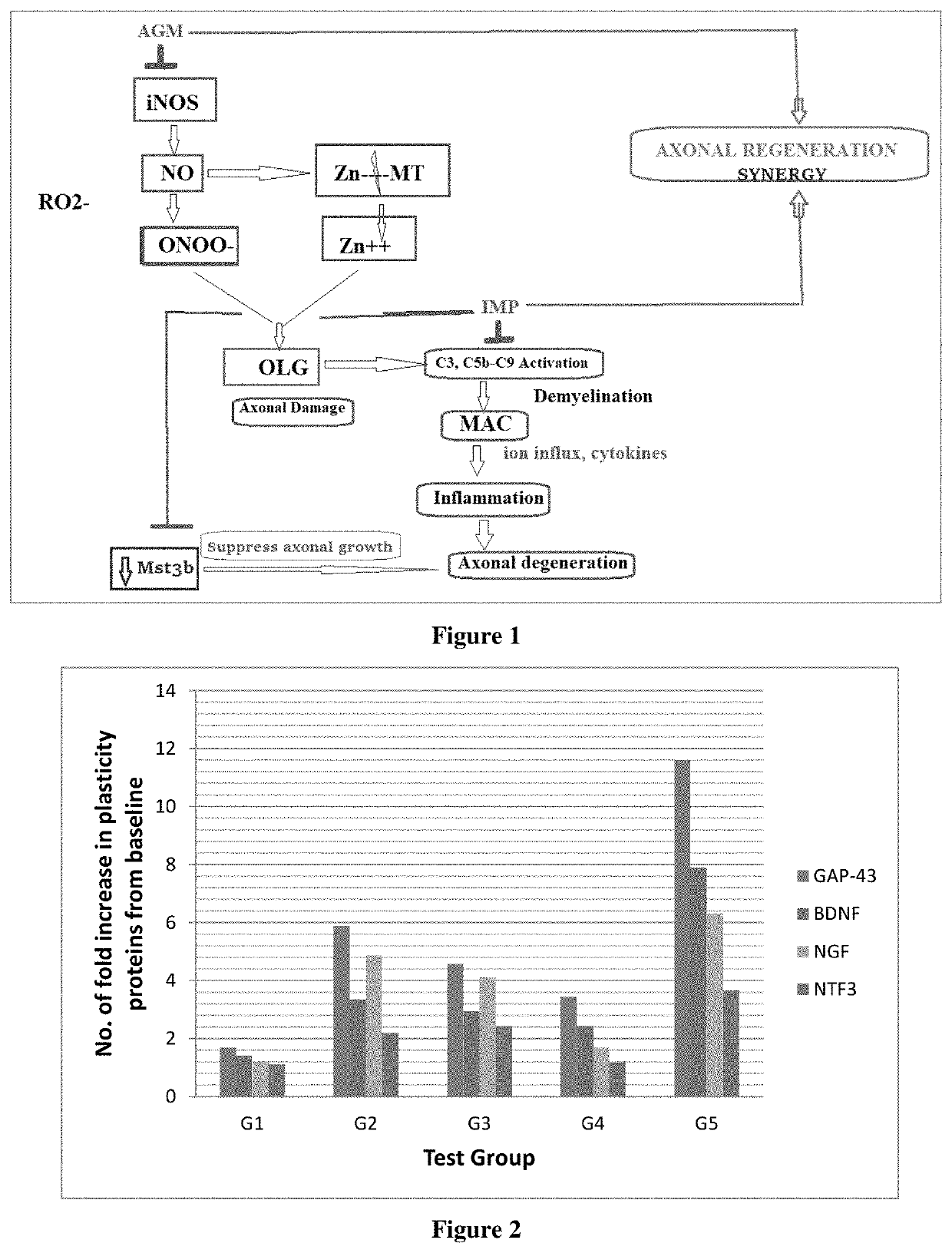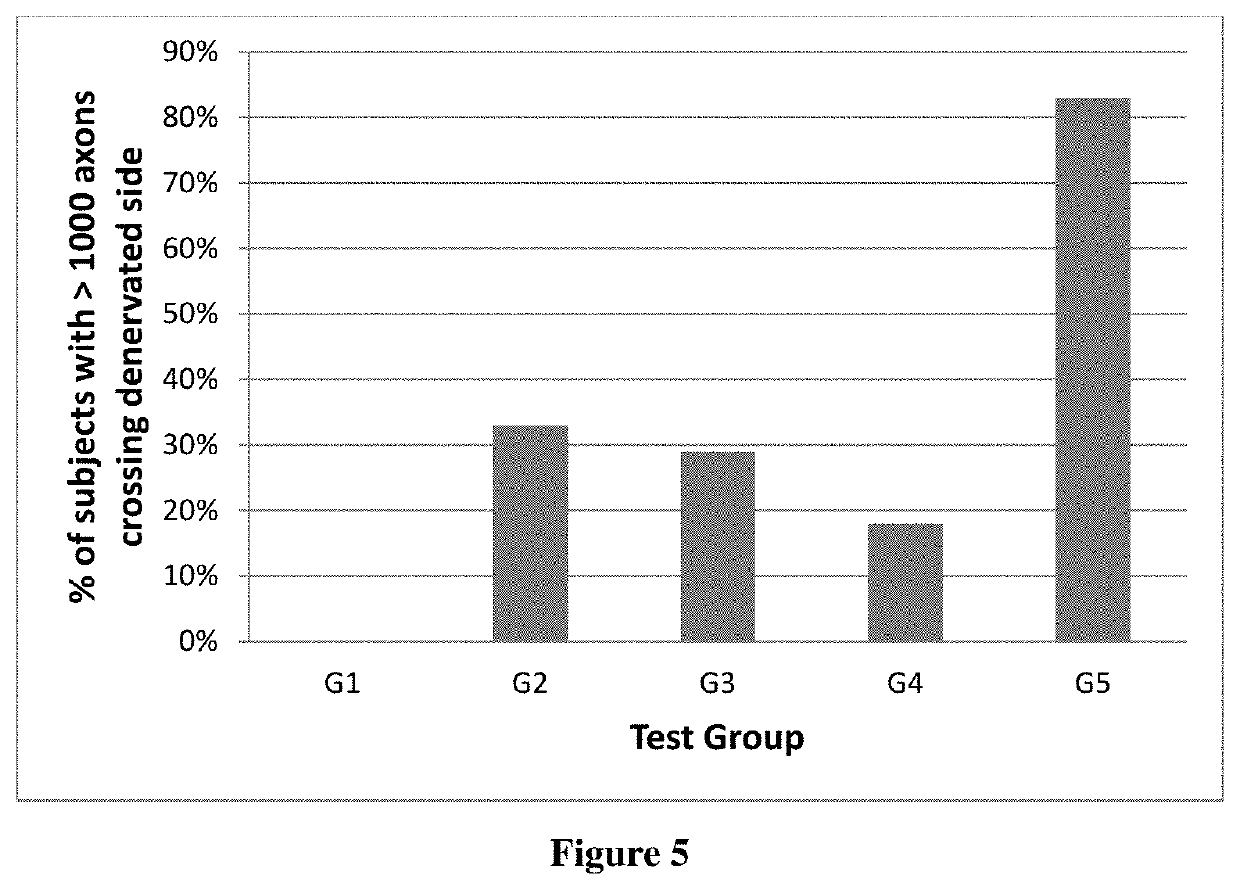Synergistic nutritional compositions for promoting axonal regeneration
a nutritional composition and axonal regeneration technology, applied in the direction of capsule delivery, drug compositions, nervous disorders, etc., can solve the problems of affecting the recovery process, unable to generate new cells, and unable to promote axonal regeneration, so as to promote axon growth and axon regeneration, promote neuronal survival, and promote neuronal regeneration.
- Summary
- Abstract
- Description
- Claims
- Application Information
AI Technical Summary
Benefits of technology
Problems solved by technology
Method used
Image
Examples
examples
[0159]Having described the basic aspects of the present invention, the following non-limiting examples illustrate specific embodiments thereof. Those skilled in the art will appreciate that many modifications may be made in the invention without changing the essence of invention.
example-1
[0160]i. Composition 1: Synergistic blend
[0161]
Ingredientw / w %Inosine Monophosphate (IMP)40%-90%Agmatine Sulphate (AGM)10%-55%
[0162]ii. Composition 2: Tablet / Capsule
[0163]
Ingredientw / w % unit doseInosine Monophosphate (IMP)60 ± 5%Agmatine Sulphate (AGM)30 ± 5%Excipient5-10%Average Wt 100%Average wt in mg800-900 mg
[0164]iii. Composition 3: Tablet / Capsule
[0165]
Ingredientw / w % unit doseInosine Monophosphate (IMP)65 ± 6%Agmatine Sulphate (AGM)25 ± 5%Excipient5-20%Average Wt100%Average wt in mg400-500 mg
[0166]v. Composition 4: Tablet / Capsule
[0167]
Ingredientmg per unit doseInosine Monophosphate (IMP)500Agmatine Sulphate (AGM)250L-Carnosine 50Microcrystalline Cellulose1-20Silicon dioxide2-15Hydroxypropyl Methylcellulose1-10Zinc Stearate1-10PVP K-305-10Talc1-10Polysorbate 801-10Mannitol1-20Propylene GlycolQSWaterQSAverage weight 800-900 mg
[0168]vii. Composition 5: Tablet / Capsule
[0169]
Ingredientmg per unit doseInosine Monophosphate (IMP)250Agmatine Sulphate (AGM)100L-Carnosine 25Sodium ascor...
example 2
udy
[0184]The purpose of this study is to evaluate the effect of the test substance in Swiss albino rats.
Test System and Animal Husbandry
Species: Mice
Strain: Swiss albino
No. of animals: 30 Animals (5 groups of 6 animals each)
Administration
[0185]Group 1 is placebo, Group 2 was given a standard treatment of antithrombotic, antiepileptic, anti-inflammatory and steroid protocol (methylprednisolone) and Group 3, Group 4 and Group 5 served as test substance. Animals were subjected to SCI and outcome measures were monitored.
Group, Designation and Dose Levels:
[0186]
TABLE 1Animal grouping and treatment detailsNo. ofGroupsGroup DescriptionDose LevelanimalsGroup 1PlaceboPhosphate-buffered6salineGroup 2Reference standard 60 mg / kg6Group 3Test I [Inosine102 mg / kg6Monophosphate disodiumsalt hydrate (IMP)]Group 4Test II [Agmatine Sulphate 51 mg / kg6(AGM)]Group 5Test I + Test II [IMP + 102 mg / kg +6AGM] 51 mg / kg
Results:
[0187]
TABLE 2No. of fold increase in plasticity proteins from baselineGAP-GroupTrea...
PUM
| Property | Measurement | Unit |
|---|---|---|
| speed | aaaaa | aaaaa |
| speed | aaaaa | aaaaa |
| weight ratio | aaaaa | aaaaa |
Abstract
Description
Claims
Application Information
 Login to View More
Login to View More - R&D
- Intellectual Property
- Life Sciences
- Materials
- Tech Scout
- Unparalleled Data Quality
- Higher Quality Content
- 60% Fewer Hallucinations
Browse by: Latest US Patents, China's latest patents, Technical Efficacy Thesaurus, Application Domain, Technology Topic, Popular Technical Reports.
© 2025 PatSnap. All rights reserved.Legal|Privacy policy|Modern Slavery Act Transparency Statement|Sitemap|About US| Contact US: help@patsnap.com



